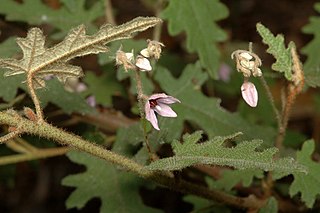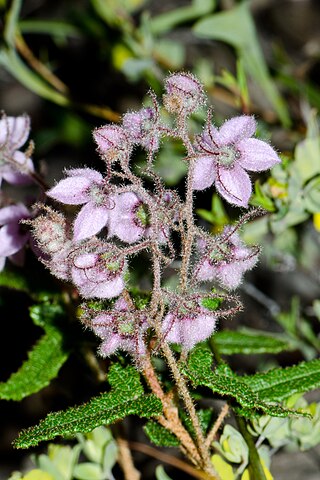
Lasiopetalum behrii, commonly known as the pink velvet bush, is a species of flowering plant in the family Malvaceae and is endemic to southern continental Australia. It is an erect shrub with lance-shaped, narrowly oblong to narrowly elliptic leaves and groups of white to pink and reddish-brown flowers.

Lasiopetalum ferrugineum, commonly known as rusty velvet-bush, is a species of flowering plant in the mallow family and is endemic to eastern Australia. Growing up to a metre tall, much of the plant is covered in rusty hairs. It is found in forest and heathland.

Lasiopetalum macrophyllum, commonly known as shrubby velvet bush, is a species of flowering plant in the family Malvaceae and is endemic to south-eastern Australia. It is a shrub with egg-shaped to lance-shaped with rust-coloured hairs on the lower surface, and woolly-hairy, cream-coloured and reddish flowers.

Oxylobium arborescens, commonly known as the tall shaggy-pea, is a species of flowering shrub to small tree in the family Fabaceae and is endemic to south-eastern Australia. It has elliptic dark green leaves and yellow pea flowers.

Thomasia purpurea is a small, flowering shrub in the family Malvaceae that is endemic to the southwest of Western Australia. It has green oblong-shaped leaves and pinkish purple flowers.

Bossiaea linophylla is a species of flowering plant in the family Fabaceae and is endemic to the south-west of Western Australia. It is a spreading shrub with linear to oblong or egg-shaped leaves, and bright yellow to orange or apricot-coloured and red flowers.

Bossiaea dentata is a species of flowering plant in the family Fabaceae and is endemic to the south of Western Australia. It is an erect, sometimes prostrate shrub with variably-shaped leaves and greenish-yellow or pink to burgundy-coloured flowers.
Lasiopetalum adenotrichum is a species of flowering plant in the family Malvaceae and is endemic to the Fitzgerald River National Park in the south of Western Australia. It is an erect shrub with hairy foliage, narrow egg-shaped to lance-shaped leaves and groups of white to cream-coloured and dark reddish-purple flowers.
Lasiopetalum angustifolium, commonly known as narrow leaved lasiopetalum, is a species of flowering plant in the family Malvaceae and is endemic to coastal areas of south-western Western Australia. It is a low spreading or dense, compact shrub with narrowly egg-shaped to narrowly elliptic leaves and compact groups of pink to purplish flowers.
Lasiopetalum compactum, is a species of flowering plant in the family Malvaceae and is endemic to the south-west of Western Australia. It is an erect shrub with leathery, narrowly oblong leaves and cymes of white to pinkish flowers.

Lasiopetalum drummondii is a species of flowering plant in the family Malvaceae and is endemic to the south-west of Western Australia. It is an erect, slender shrub with many densely hairy stems, egg-shaped or oblong leaves and white, pink and red flowers.
Lasiopetalum ferraricollinum is a species of flowering plant in the family Malvaceae and is endemic to the south-west of Western Australia. It is an upright shrub with densely hairy stems, narrow egg-shaped to oblong leaves and white to cream-coloured and dark red flowers.
Lasiopetalum longistamineum is a species of flowering plant in the family Malvaceae and is endemic to a restricted area of New South Wales. It is a spreading shrub with its branches densely covered with woolly, rust-coloured hairs and has egg-shaped leaves and woolly-hairy flowers.

Lasiopetalum oldfieldii is a species of flowering plant in the family Malvaceae and is endemic to the south-west of Western Australia. It is a low, spreading shrub with rusty-hairy young stems, egg-shaped to narrowly egg-shaped leaves and pink and dark red flowers.

Lasiopetalum parviflorum is a species of flowering plant in the family Malvaceae and is endemic to south-eastern continental Australia. It is a shrub with rusty-hairy stems, more or less glabrous leaves with the edges rolled under, and greenish to cream-coloured flowers.

Lasiopetalum pterocarpum, commonly known as wing-fruited lasiopetalum, is a species of flowering plant in the family Malvaceae and is endemic to a restricted area in the south-west of Western Australia. It is an open shrub with many densely hairy stems, egg-shaped and lobed leaves and pink and dark red flowers.

Lasiopetalum trichanthera is a species of flowering plant in the family Malvaceae and is endemic to a restricted area in the south-west of Western Australia. It is an erect to straggling, sticky shrub with many hairy stems, egg-shaped leaves and bright pink and dark red flowers.

Lasiopetalum venustum is a species of flowering plant in the family Malvaceae and is endemic to a restricted area in the south-west of Western Australia. It is an erect shrub with hairy stems, egg-shaped, three-lobed leaves and pink and dark red flowers.
Stenanthemum stipulosum is a species of flowering plant in the family Rhamnaceae and is endemic to inland Western Australia. It is an erect or low-lying shrub with densely hairy young stems, egg-shaped with the narrower end towards the base, and clusters of 10 to 30 densely hairy white or cream-coloured flowers, sometimes surrounded by whitish floral leaves.
Seringia adenolasia is a species of flowering plant in the family Malvaceae and is endemic to northern Australia. It is a sticky, aromatic densely hairy shrub with egg-shaped to lance-shaped leaves sometimes with toothed edges, and creamy-pink or purple flowers, usually in groups of up to 5.













